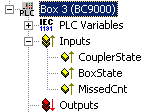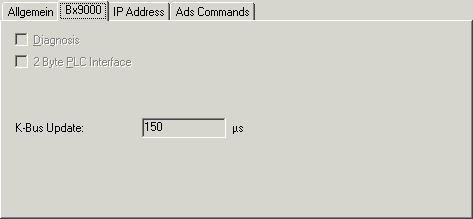BC9000 (Ethernet Interface)
The Beckhoff BC9000 Bus Terminal Controller is to be configured in TwinCAT under a "Virtual Ethernet Interface". The following description explains the differences between the BC9000 and other Bus Couplers or Bus Terminal Controllers.
The Ethernet Bus Terminal Controller communicates via TCP/IP or UDP (and ADS as the Application Layer on top of it)) with TwinCAT. For an Overview of all currently supported Ethernet Bus Terminal Controllers, please see...
Diagnosis Inputs:

The directly below the Busterminal Controller listed PLC Variables are described under "Data Exchange PC / Bus Terminal Controller".
Each fieldbus module contains status information which can be linked to TwinCAT (e.g. to to TwinCAT PLC). These status information are mostly identical at all Beckhoff fieldbus nodes (see CouplerState, MissedCnt)) and are described under -> "Status Information - Beckhoff Fieldbus nodes". Only the input variable BoxState is specific and therefore described below. This variable can contain following values, which are described inside the below table. Additionally, each variable status is listed in the corresponding "Comment" field.
Variable | Data Type | Value | Description |
|---|---|---|---|
BoxState | UINT16 | 0x0000 | No error |
0x0001 | No new Input information | ||
0x0002 | Outputs disabled (only with UDP) | ||
0xnn00 | nn = current warning level (only with UDP) |
"Bx9000" Tab

Diagnosis: This checkbox is deactivated for the BC9000.
2 Byte PLC Interface: This checkbox is deactivated for the BC9000.
K-Bus Update: According to the attached Bus Terminals, the estimated K-Bus update time is calculated and displayed here.
Notice | |
The ("cycle ticks") task time for the respective task should be selected to be so high that the value displayed at MissedCnt is always constant. In the event of doubt, it is better to select a slightly higher cycle time. |
Example:
Minimum cycle time with selected protocol UDP: 30 ms
Minimum cycle time with selected protocol TCP: 50 ms